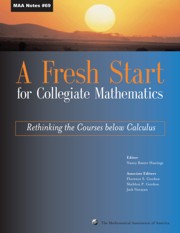Book contents
- Frontmatter
- Preface
- Contents
- Introduction
- Background
- Theme 1 New Visions for Introductory Collegiate Mathematics
- Theme 2 The Transition from High School to College
- Theme 3 The Needs of Other Disciplines
- Theme 4 Student Learning and Research
- Theme 5 Implementation
- 21 Some Political and Practical Issues in Implementing Reform
- 22 Implementing Curricular Change in Precalculus: A Dean's Perspective
- 23 The Need to Rethink Placement in Mathematics
- 24 Changing Technology Implies Changing Pedagogy
- 25 Preparing for Calculus and Beyond: Some Curriculum Design Issues
- 26 Alternatives to the One-Size-Fits-All Precalculus/College Algebra Course
- Theme 6 Influencing the Mathematics Community
- Ideas and Projects that Work: Part 1
- Ideas and Projects that Work: Part 2
23 - The Need to Rethink Placement in Mathematics
from Theme 5 - Implementation
- Frontmatter
- Preface
- Contents
- Introduction
- Background
- Theme 1 New Visions for Introductory Collegiate Mathematics
- Theme 2 The Transition from High School to College
- Theme 3 The Needs of Other Disciplines
- Theme 4 Student Learning and Research
- Theme 5 Implementation
- 21 Some Political and Practical Issues in Implementing Reform
- 22 Implementing Curricular Change in Precalculus: A Dean's Perspective
- 23 The Need to Rethink Placement in Mathematics
- 24 Changing Technology Implies Changing Pedagogy
- 25 Preparing for Calculus and Beyond: Some Curriculum Design Issues
- 26 Alternatives to the One-Size-Fits-All Precalculus/College Algebra Course
- Theme 6 Influencing the Mathematics Community
- Ideas and Projects that Work: Part 1
- Ideas and Projects that Work: Part 2
Summary
Several years ago, Richard Riley, secretary of education in the Clinton administration, challenged the mathematics community to address the problems of articulation in mathematics education between high schools and two- and four-year colleges. Riley called for this national initiative, through the National Research Council, because of the growing breakdown in the once smooth transition between high school and college mathematics, as well as the differences between mathematical experiences in different colleges when students transfer from one institution to another.
In large measure, many of the problems with mathematical transitions are due to the rapidly growing reform movements in mathematics education, both at the secondary level and at the college level. NCTM's efforts to promote a school curriculum based on their Standards documents are bearing fruit around the country, as described in other articles in this volume. Instead of the relatively uniform secondary curriculum that most of us went through, many schools across the country have implemented a variety of reform curricula that provide students with very different content and very different teaching and learning environments.
There is a major emphasis on conceptual understanding, not just routine manipulation;
There is an emphasis on realistic problems, not just artificial template problems whose solutions are to be memorized and regurgitated;
There is an emphasis on mathematics via discovery, not mathematics as a collection of facts and procedures to be memorized;
There is an emphasis on the use of technology;
There is an emphasis on writing and communication and working collaboratively.
- Type
- Chapter
- Information
- A Fresh Start for Collegiate MathematicsRethinking the Courses below Calculus, pp. 224 - 228Publisher: Mathematical Association of AmericaPrint publication year: 2006
- 2
- Cited by



